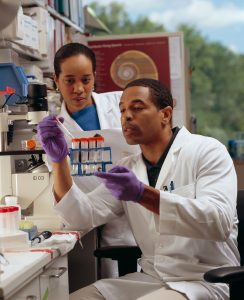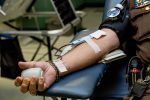Have you ever thought about becoming a phlebotomist?
But you are afraid that you will not have a permanent job or have a small wage?
The medical industry is growing every day, resulting in more hospitals and labs opening.
Our team has done significant research, and the results are astonishing.
The results have shown the following:
In just about ten years, the work area is expected to grow by approximately 27%, demonstrating that the demand was never higher.
If this sounds like something that’s up to your alley, then a job as a phlebotomist is the right one for you.
Appropriately, it requires having a very organized personality too.
Despite all that we have enumerated, choosing a healthcare career has many good sides.
Which offers:
- Stable job
- High annual wage ( 29,730 USD)
- Advancement opportunities
- It does not require you to complete an accredited program.
Although the certificate is not binding, this type of credential will help you stand out from the competition and probably give you a higher wage and enable you better employment opportunities.
The training program you’ll have to choose can significantly affect the type of position you qualify for.
These types of programs are available at:
- Vocational schools
- Community colleges
- Universities
- Technical schools
Page Navigation
What Is a Phlebotomist?
As you may know, a phlebotomist’s job is to get the patient’s blood and work with new technology and computers while working with children and people with a needle phobia.
Any medical practitioner trained in drawing blood from a patient can be considered qualified in phlebotomy.
Qualified phlebotomists practice something known as venipuncture.
Phlebotomists perform other duties.
A phlebotomist may be responsible for preparing the patient, explaining the patient’s procedures, restoring hemostasis to the puncture site, delivering blood samples, and more.
Not only will you be happy to draw blood, but you will also want to have skills for being polite to the patients.
You treat dozens of patients every day, many of whom may not feel comfortable with needles or hemorrhoids.
The phlebotomist, in this sense, must also be able to help the patient understand why a test is necessary and ensure that they receive the most accurate test possible.
Venipuncture
Venipuncture is a procedure that involves drawing blood in need of further testing to detect or more efficiently treat a disease.
Phlebotomists can also draw blood for donations, researches, or even blood transfusion.
After drawing as many blood samples as instructed, your job as a phlebotomist is to label the samples and transport them to a lab where the laboratory personnel can test them.
In many cases, a phlebotomist can even collect minimal amounts of blood with his or her fingers. Depending on the tests, the patient needs to treat and diagnose specific conditions, such as HIV testing. Or glucose monitoring.
Phlebotomists can also draw blood from a patient for blood donation, blood transfusions, and even research.
From all that we have said, we can emphasize that venipuncture is actually a quite long process that is essential for diagnosing the patient’s condition.
This is a daily thing for a phlebotomist because they do venipuncture multiple times a day. Of course, this depends on their workplace.
What Else Might You Need to Do as a Phlebotomist?
As in other professions, phlebotomists have other responsibilities and tasks as well, including:
- Preparing the patient
- Delivering blood samples
- Restoring hemostasis of puncture sites
- Explaining procedures to patients
Phlebotomist School: The Key to Success
Although it is not mandatory to have a certificate, having it will make you stand out of the already colossal competition аnd help you to secure a more stable and highly paid job.
Furthermore, by participating in these courses, you ensure that you are maximally ready to perform your duty and provide the best care for your patients.
What Features Do You Need to Possess to Qualify for Enrollment?
Оur team did extensive research that covered most of the institutions and colleges that offer any phlebotomy training.
Тhe research was successful and brought significant results on what you need to possess to qualify for this type of activity, including:
- You must be at least eighteen years old.
- You need to have a clean criminal record.
- It would be best if you have up-to-date immunizations.
- You’ll have to pass a drug screen as well.
- You’ll need to possess a high school diploma or a GED.
- Certification (not necessary).
Furthermore, taking a phlebotomy course is a great way to make sure you are ready to start a career in phlebotomy.
Suppose you have ever wanted to join the medical field but are not interested in pursuing a degree and a career as a doctor or nurse.
In that case, a phlebotomist is a great way to get involved and explore your passion for helping patients.
With a certification as a licensed phlebotomist, not only will you have a better chance of hiring, you ensure that you are as experienced as you can in providing this vital service to your patients.
What Should You Do Before Enrolling?
First of all, you’ll need to do thorough research to determine if the school you’re interested in have its system featured by an accredited program, which means that a certifying agency has approved it.
If the program is not accredited, you won’t be able to take the certification exam after graduation.
This statement is of inestimable importance for those of you who live in countries that require certification, such as:
- California
- Nevada
- Louisiana
- Washington
Consequently, it means that you should avoid any online programs or courses for phlebotomy derived by for-profit organizations such as Phoenix University.
But this does not mean that you should not consider obtaining accreditation in other countries.
The medical field is extremely competitive.
In that case, a phlebotomist is a great way to get involved and explore your passion for helping patients.
Having a certificate and experience in this field shows that you are serious about your career and will help you stand out from other candidates.
With the certification obtained, you become a licensed phlebotomist.
By getting accredited to your certification to become a licensed phlebotomist, you have many benefits, guaranteeing that you are as experienced as you can provide this vital service to your patients.
Before enrolling, you should do extensive research to determine if the school you are interested in has an accredited program.
If the program is not accredited, you will not be eligible to take the certification exam upon graduation.
Depending on whether you go full-time or part-time, the program’s length will be different as well, so we think that this is something you want to consider before enrolling in a phlebotomy program.
Phlebotomist’s Clinical Training
The training you will attend will last for 6 to 12 months and usually be held in a clinical or medical environment.
It is important to note that the time you’ll complete the entire training will drastically affect the work position.
By participating in the training, you’ll be learning how to perform your duties as a phlebotomist in the best possible way.
Moreover, you will be able to get acquainted with the curriculum of the course itself, which includes:
- Venipuncture procedures
- Human anatomy
- Medical terminology
- Medical ethics
- Specimen care
- Patient interaction
- Practicing simulated venipuncture procedures
- Practice blood draw techniques (on mannequin arms)
- Clinical training
- Practical training
Any phlebotomy program curriculum will cover a subject including venipuncture procedures, medical ethics, patient interaction, sample care, medical terminology, and human anatomy.
Here you will be trained on how to interact in various medical conditions and execute your daily duties.
The class part of the program also includes laboratories that allow students to practice simulated venipuncture procedures.
These labs will enable the student to work on hand modeling and practice blood drawing techniques.
But part of the phlebotomy course also includes clinical, practical training.
Let’s look at what this involves.
The classes are designed especially to prepare you for the program’s clinical part, providing you with the skills and knowledge needed to feel confident working with patients.
Some colleges offer phlebotomy courses to complete just two semesters.
As we’ve said above, the time it takes you to complete the phlebotomy program will depend entirely on your school and your schedule.
Every program has different schedules and different tuitions, but on average, expect your total tuition to be around $2,000, excluding the required textbooks. Financial aid and student loans, of course, are available with most programs if needed.
The clinical part of the program will take place at a local hospital or clinic.
Students will initially approach professional phlebotomists as they interact with patients and associates.
Most require performing multiple times of unwanted venipunctures to graduate and successfully feel comfortable with the process.
While working as an intern in a medical institution, the phlebotomy student will work under professional phlebotomists and its staff’s direct supervision.
Usually, the clinical work section consists of forty hours of practical training.
To qualify for the certification, you will have to complete one hundred venipuncture assistance procedures.
While most of the students will initially find the clinical work daunting, however, students will feel confident enough to complete the venipuncture independently by the last week.
They will also learn about medical terminology, read the doctor’s instructions, and successfully communicate with patients from different backgrounds, and explain the procedure step by step.
What Will Your Life Look Like after Graduation?
After graduation, you will have a variety of employment options.
You can start your employment in dozens of medical facilities, starting from the hospital through the clinics and private practices up to the federal labs.
Primarily, jobs as a phlebotomist are divided into several divisions, including:
- Mobile phlebotomist – ideal for those who enjoy traveling
- Working in hospices and home health agencies – They intend to hire entry-level and an experienced phlebotomist to provide the best possible care for patients in their own homes because they cannot travel due to illness or injury.
- Working in more extensive medical facilities – Ideal for those who intend to be provided with opportunities for career advancements, such as a supervisor or leading tech phlebotomist
The Bottom line
From all that we’ve said, you need to keep in mind that:
- You need to do thorough research to determine if the school you’re interested in has its system featured by an accredited program, which means that a certifying agency has approved it.
- Having a certificate and experience in this field shows that you are serious about your career and will help you stand out from other candidates.
- By participating in the training, you’ll be learning how to perform your duties as a phlebotomist in the best possible way.
- Any phlebotomy program curriculum will cover a subject including venipuncture procedures, medical ethics, patient interaction, sample care, medical terminology, and human anatomy.
- While working as an intern in a medical institution, you will work under professional phlebotomy and its staff’s direct supervision.
- Working in a larger medical facility, where there are some phlebotomists, can give you career advancement opportunities.
- Hospitals and home health agencies will hire experienced and novice phlebotomists to provide care for patients in their homes because they cannot travel due to illness or injury.
In conclusion, we can say that it has never been a better time to consider a career in phlebotomy for someone young with the vision.
This page is also available in Spanish.










